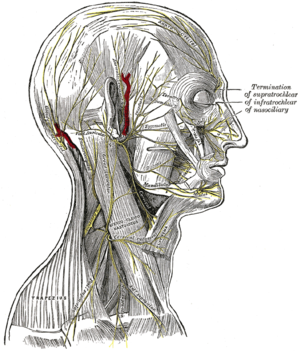Greater Occipital Nerve Injection
From WikiMSK
Background
- Therapeutic and diagnostic for occipital neuralgia
- Nerve is between ~8-18 mm deep[1]
Indications
- Suspected or confirmed occipital neuralgia
- Migraine refractory to conservative treatment
- Post-lumbar puncture headache refractory to conservative treatment
- Cluster headache, occipital neuralgia, cervicogenic headache, or migraine with occipital nerve irritation or tenderness [2]
Contraindications
- Infection overlying injection site
Equipment Needed
- PPE
- Syringe and 27-30ga needle
- Betadine or chlorhexidine
- Local anesthetic
- 40mg of methylprednisolone or triamcinolone may be mixed with the local anesthetic[3], but efficacy has not been proven.
Procedure
- Patient in position of comfort allowing access to posterior head and neck. (laying prone or sitting with head down in arms)
- Identify Greater Occipital Nerve (GON).
- Cleanse skin with betadine or chlorhexidine and allow to dry
- Insert needle over nerve at 90 degrees to skin until hit bone, then withdraw slightly[6]
- If using ultrasound, insert needle at 45 degrees to skin and advance toward nerve under direct ultrasound guidance
- Aspirate to ensure not in vessel.
- Inject ~1-3 mL of local anesthetic. (may inject small amount medial and lateral to nerve to ensure adequate block)[3]
- Repeat on contralateral side, if indicated.
Maximum Doses of Anesthetic Agents
| Agent | Without Adrenaline | With Adrenaline | Duration | Notes |
| Lidocaine | 5 mg/kg (max 300mg) | 7 mg/kg (max 500mg) | 30-90 min |
|
| Mepivicaine | 7 mg/kg | 8 mg/kg | ||
| Bupivicaine | 2.5 mg/kg (max 175mg) | 3 mg/kg (max 225mg) | 6-8 hr |
|
| Ropivacaine | 3 mg/kg | |||
| Prilocaine | 6 mg/kg | |||
| Tetracaine | 1 mg/kg | 1.5 mg/kg | 3hrs (10hrs with epi) | |
| Procaine | 7 mg/kg | 10 mg/kg | 30min (90min with epi) |
Complications
Complications are rare due to superficial location and lack of major surrounding structures.[3]
- Damage to surrounding structures
- Bleeding
- Infection
Follow-up
- Follow up with appropriate specialist for the indication for nerve block.
See Also
References
- ↑ M. Greher, B. Moriggl, M. Curatolo, L. Kirchmair and U. Eichenberger. Sonographic visualization and ultrasound-guided blockade of the greater occipital nerve: a comparison of two selective techniques confirmed by anatomical dissection. Br. J. Anaesth. (2010) 104 (5): 637-642.
- ↑ https://www.nuemblog.com/blog/occipital-nerve-block
- ↑ 3.0 3.1 3.2 Brock G. The occasional greater occipital nerve block. Can J Rural Med. 2014 Fall;19(4):152-5.
- ↑ Dach F, Éckeli ÁL, Ferreira Kdos S, Speciali JG. Nerve block for the treatment of headaches and cranial neuralgias - a practical approach. Headache. 2015 Feb;55 Suppl 1:59-71.
- ↑ Palamar D, Uluduz D, Saip S, et al. Ultrasound-guided greater occipital nerve block: an efficient technique in chronic refractory migraine without aura? Pain Physician. 2015 Mar-Apr;18(2):153-62.
- ↑ Inan LE, Inan N, Karadaş Ö, et al. Greater occipital nerve blockade for the treatment of chronic migraine: a randomized, multicenter, double-blind, and placebo-controlled study. Acta Neurol Scand. 2015 Mar 13. doi: 10.1111/ane.12393



